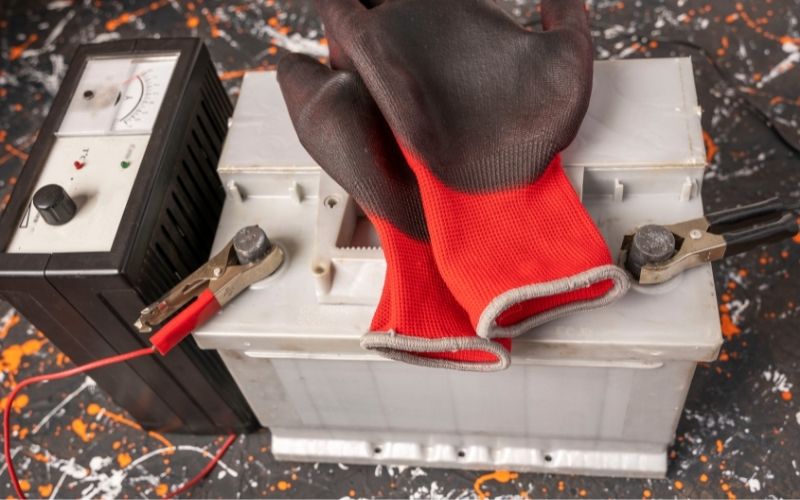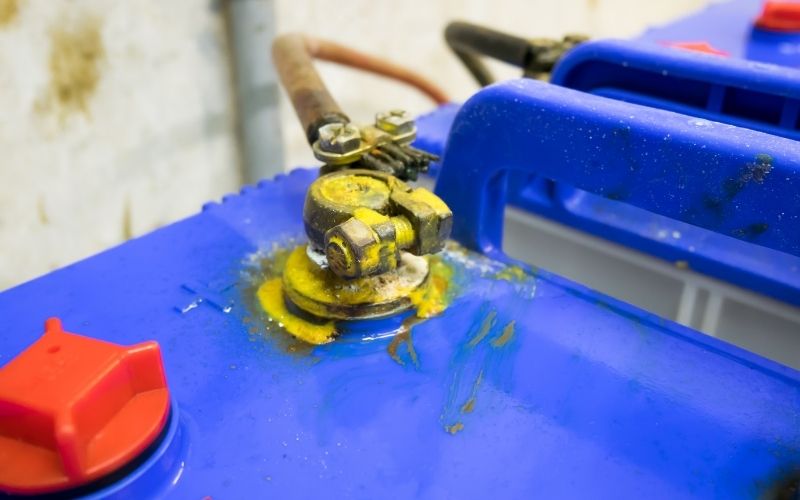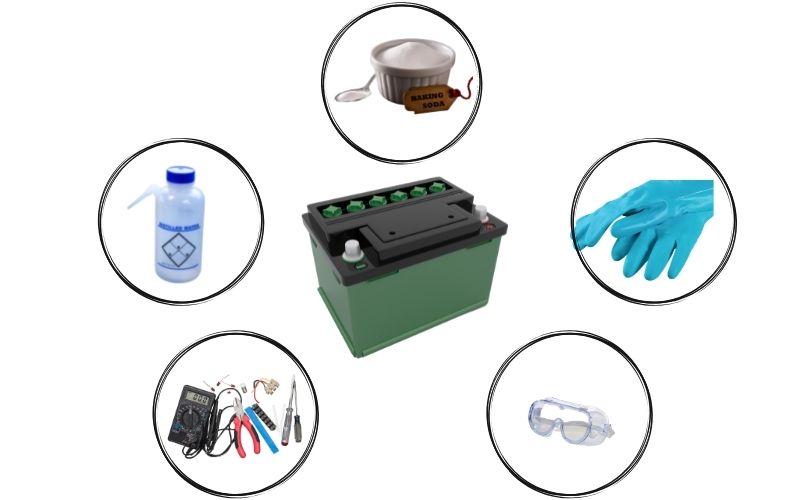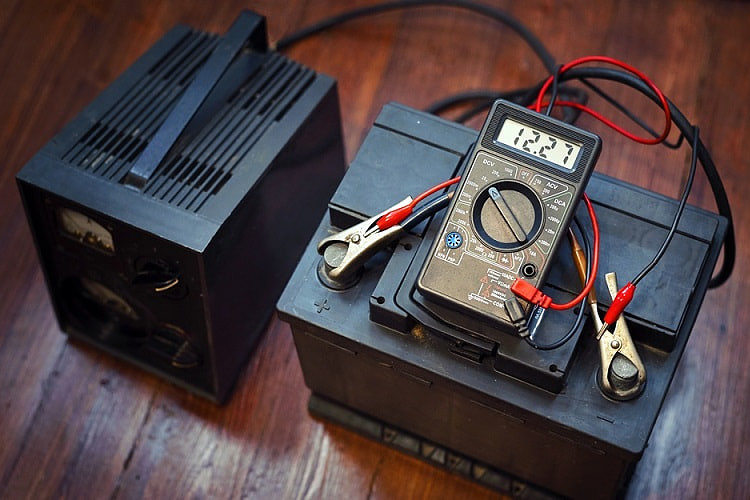You have a marine battery that has been pronounced as dead by the marine store technician. Of course, he would prefer that you buy a new battery.
You are determined to see if you can get the marine battery to take a charge. That would give you extra funds that you could put toward some new electronics for your boat.
If the battery does take a charge, what are the chances of reconditioning it?
But how do you recondition a dead marine battery, and would that be more economical than buying a new one?
Let’s investigate and find out.
Can A Dead Marine Battery Be charged?

Dead marine batteries, like dead car batteries, can be charged. This does not mean the battery will hold the charge, but it is possible.
You can use a good battery, or a battery pack, to attempt the charge. Be sure to wear goggles and long sleeves for protection.
Use jumper cables to connect the dead battery to the good battery, positive to positive and negative to negative. Start your motor to jump start the dead battery. Keep the motor running for twenty minutes to allow enough charging time.
Just because a marine battery has accepted a charge, that does not mean it will hold the charge. You can test the battery using a voltmeter. The voltage reading should show 12.7 for a 12-volt battery to be considered fully charged.
You will need to continue checking your battery to be sure it is holding the charge. If the battery does not accept the original jump start and charge, you should visit a marine store and purchase a new one.
There are ways to prepare a dead marine battery to increase your chances that it will accept a jump start and hold the charge. You can mix one part epsom salt with three parts of distilled water. Add the solution equally to the battery cells.
You can also use aspirin. Make a powder from twelve 350 mg aspirins. Mix this with six ounces of distilled water. Again, add this solution to the battery cells.
So, dead marine batteries can be charged. But follow-up testing is needed to determine if it has held the charge.
Table of Contents
Does Reconditioning Really Work?
Reconditioning a marine battery can work. To determine if you can recondition a battery, first clean it. Check to see if the corrosion has built up on the battery.

Check the appearance of the battery. If it has cracks, excess corrosion, or shows extreme wear and tear, replace the battery. If the battery is more than four years old it is not a candidate for reconditioning.
How Do You Recondition A Battery?
But if the battery is a good candidate, the process is simple. Mix baking soda with water. You should include one pound of baking soda for each gallon of water you use. This solution is used to remove corrosion.

Once all corrosion has been removed, clean the battery terminals and clamps using post and clamp cleaner.
Next, charge the battery with a three-stage charger .
During the first stage, this charger determines the amount of charge the battery will need. When the battery has reached approximately 80% of its capacity, the battery will start to cool down.
In the final stage, the battery is “topped off” with charge. The battery receives a steady charge until it reaches its full capacity. The charge is trickled in, depending on the amount of charge the battery needs.
When the charge is complete, remove the vent caps. Fill the openings with distilled water to a level that is just above the plates.

Next, allow the battery to discharge. This is a critical step to determine if the reconditioning has worked.
Discharge the battery for a few hours. Try to get it down to zero volts, or at least near to it.
Charge the battery again. For the best results, replace the old battery plates with new ones.
Even if the reconditioning does work, do not expect the battery to have the same power that a new battery has. You can expect about seventy percent of new battery power at best.
The good news is that this is enough power for starting. But you should get another battery if you need to power onboard components as well.
Consider Purchasing A Reconditioning Kit

But what do you do if you don’t want to take the time to gather the materials necessary to recondition the dead battery? Fortunately, there are kits available to help you. You get the chemicals and the instructions to complete the job.
You can shop at your marine store or check on eBay. The kits help you clean the lead plates in the battery. There are kits for marine, deep cycle, and even solar panel batteries.
Enough materials are usually included to revive multiple batteries. That way, you can recondition your starter battery and the battery you use for your components.
If the batteries are frozen or have a cell that is no longer good, the chemical mixture is not likely to work. So test the battery cells first using a hydrometer, which you can purchase from your marine store.
A hydrometer measures the gravity of the battery cells. It compares the weight of the solution to the weight of the same volume of water.

When performing this test, wear gloves and safety glasses . Disconnect the battery, removing the negative cable first, and then the positive cable. Connect the battery to a charger.
Once the charge is complete, remove the leads from the charger. Take the plastic caps off of the top of the battery with a screwdriver.
Insert the hydrometer into each cell and remove the fluid. Check the reading on the hydrometer. If any cell has a reading of 0.05 less than the other cells, that cell is dead.
In this case, you will need to purchase a new battery. But if the hydrometer test indicates good cells, the battery could be salvageable.
Conclusion
Dead marine batteries can accept a charge, but that does not mean they always will. To have the best chance of success, you should clean the battery first. Look for cracks or swelling in the battery before proceeding.
Clean the battery with a mixture of baking soda and water. Use clamp cleaner to clean the battery terminals.
When all corrosion is removed, you can recondition the battery. To make the job easier, consider purchasing a reconditioning kit. This will ensure that you have all the necessary materials.
Reconditioning kits typically help you to recondition more than one battery. So you can recondition a starting battery and also a battery to run your onboard components.
Use a hydrometer to test the individual battery cells before reconditioning the battery. Make sure the battery plates are cleaned thoroughly.
By saving a few dollars on the cost of a new battery, you can get some extra bait and maybe even reel in more fish!

I created this site to help people – to help you – with your boat problems. Instead of helping one person at a time, I want this website to be the “one-stop-shop” for everyone’s boating concerns. Read more.

